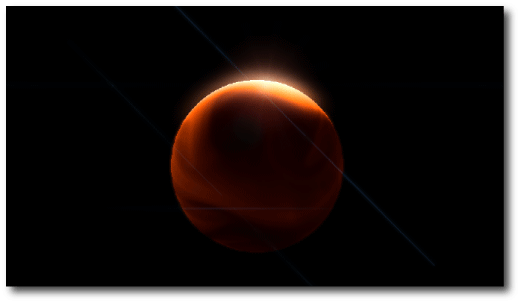
Image Source.
The Spitzer telescope recently observed HAT-P-2b (data not yet analyzed) and the Nov. 19-20th encounter with HD 80606b is coming right up. No better time, then, to go out on a limb with our predictions of what will be seen. Our latest paper (Langton & Laughlin 2007) has been accepted by the Astrophysical Journal, and will be posted to astro-ph shortly. In the meantime, here’s a .pdf file containing the full paper. We’re happy with the way it came out, and we’re working hard to push the models to the next level.
From the conclusion:
A short-period Jovian planet on an eccentric orbit likely presents one of the Galaxy’s most thrilling sights. One can imagine, for example, how HD 86060 b appears during the interval surrounding its hair-rising encounter with its parent star. The blast of periastron heating drives global shock waves that reverberate several times around the globe. From Earth’s line of sight, the hours and days following periastron are characterized by a gradually dimming crescent of reflected starlight, accompanied by planet-wide vortical storms that fade like swirling embers as the planet recedes from the star. It’s remarkable that we now have the ability to watch this scene (albeit at one-pixel and two-frequency resolution) from a vantage several hundred light years away.

Having seen the animations of these eccentric systems a while back, I really enjoyed reading the article draft. The color figures make it one of the most – if not THE most – visually exciting technical publication on exoplanets that I’ve found so far. And having wondered “What makes them all so different?” I especially appreciated Section 4, where this question is considered in detail.
I’m fascinated by the amount of progress that’s happening in the study of close-in giant planets. Remember when Geoff Marcy was calling them “Marauding Jupiters,” like hostile barbarians that pillaged & plundered well-behaved planetary systems? Artists back then generally depicted them with colorful cloud bands, Red Spots, and lots of rings & moons. Now, thanks to Langton & Laughlin, we have scientifically plausible simulations of what their weather may actually look like. I bet (and hope) that the space artists draw major inspiration from this paper’s figures.
One small question for Greg – I notice that you used Bakos’ values for HAT-P-2b, rather than the more recent numbers from Loeillet & colleagues (2007arXiv0707.0679L) – maybe because your simulations were already cooking by the time their paper started circulating. The more recent paper gives a larger mass (~8.64) and smaller radius (~0.952) for the planet. Would those figures have made any difference in your results?